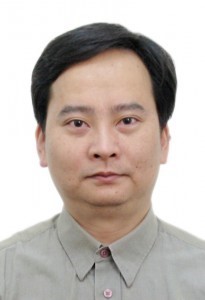
胡方,男,汉族,1972年2月生于浙江宁波,研究员,创新工程“语音与言语科学重点实验室”首席研究员。1995年获复旦大学中国语言文学系汉语言学专业文学学士学位,2005年获香港城市大学中文、翻译及语言学系语音学与音系学专业哲学博士学位。2003年3月至今,在中国社会科学院语言研究所工作,历任助理研究员、副研究员、研究员,语音研究室副主任。
现从事语言学研究,学术专长是语音学,研究旨趣一方面着重于用现代科学技术手段描写汉语及相关方言、语言中的语音现象,另一方面则着眼于在人类语言的语音多样性中寻找普遍性。
主持的研究项目
社科基金名称:汉语方言研究的实验语音学理论与方法(15BYY073),(2015年-2018年), 在研。
发表学术成果
专著与编著
1.胡方《宁波话元音的语音学研究》(英文),中国社会科学出版社,2014。
2.胡方、唐正大、陈振宇(执行编辑)《语言研究集刊》第十辑,上海辞书出版社2013。
3.周志锋、胡方《北仑方言》,中国文史出版社,2007。
论文
1.Hu, F. &Ge, C. Vowels and Diphthongs in Cangnan Southern Min Chinese Dialect. Proceedings of Interspeech 2016, San Francisco, USA,2016.
2.Xia, L. & Hu, F. Vowels and Diphthongs in the Taiyuan Jin Chinese Dialect. Proceedings of Interspeech 2016, San Francisco, USA, 2016.
3.Hu, W., Hu, F. & Jin, J. Diphthongization of Nuclear Vowels and the Emergence of a Tetraphthong in Hetang Cantonese. Proceedings of Interspeech 2016, San Francisco, USA, 2016.
4.Hu, F. Tones are not abstract autosegmentals. Speech Prosody 2016, Boston, USA, 2016.
5.Zhang, Minghui&Hu, Fang. Tone features in XiuningHui Chinese dialect.《中国语音学报》第六辑,中国社会科学出版,2016.
6.Hu, F. & Zhang, M. On the Diphthongized vowels in QimenHui Chinese. Proceedings of the 18th International Congress of Phonetic Sciences (ICPhS 2015), Glasgow, Scotland, 2015.
7.Zhang, M. & Hu, F. Tone features in QimenHui Chinese Dialect. Proceedings of the 18th International Congress of Phonetic Sciences (ICPhS 2015), Glasgow, Scotland, 2015.
8.Zhang, Q. & Hu, F. The Vowel Inventory in the Xinfeng (Tieshikou) Hakka Dialect. Proceedings of the 18th International Congress of Phonetic Sciences (ICPhS 2015), Glasgow, Scotland, 2015.
9.胡方《浙江景宁畲话的语序及其表达功能》,载刘丹青、李蓝、郑剑平主编《方言语法论丛》(第六辑)367-373页,中国社会科学出版,2015.
10.Hu, F. & Zhang, M. Diphthongized Vowels in the Yi County Hui Chinese Dialect. Proceedings of Interspeech 2014, pp. 1703-1707, Singapore, 2014.
11.Fang, Q., Wei, J. & Hu, F. Reconstruction of Mistracked Articulatory Trajectories. Proceedings of Interspeech 2014, pp. 2342-2345, Singapore, 2014.
12.Fang, Q., Hu, F., Wei, J., Li, A. & Wang, H. “Estimating the position of mistracked coil of EMA data using GMM-based methods”, APSIPA 2013.
13.Yu, J., Li, A., Hu, F., Fang, Q., Jiang, C., Li, X., Yang, J. & Wang, Z. “Data-driven 3d visual pronunciation of Chinese IPA for Language learning.”Oriental Cocosda, 2013.
14.胡方《降峰双元音是一个动态目标而升峰双元音是两个目标:宁波方言双元音的声学与发音运动学特性》,《语言研究集刊》第十辑,12-37页,上海辞书出版,2013.
15.邱玥、胡方《隆昌话的元音》,《语言研究集刊》第十辑,38-51页,上海辞书出版,2013。
16.Li, A., Cao, M., Fang, Q., Hu, F., & Dang, J. Acoustic and Articulatory analysis on Chinese and Japanese Vowels in Emotional Speech, In Chinese Journal of Phonetics, 《中国语音学报》Vol. 4, pp. 125-142, Beijing: China Social Sciences Press, 中国社会科学出版社2013.
17.Hu, Fang. Tonogenesis in Lhasa Tibetan – Towards a gestural account. In Hoole, P. et al. (eds.) Consonant Clusters and Structural Complexity, pp. 231-254. Mouton De Gruyter, 2012.
18.Hu, F., Wu, Y., Xu, W. & Han, D. (2012). Articulatory Strategies in Obstruent Production in Mandarin Esophageal Speech. Proceedings of Interspeech 2012, Mon. 01c. 01, Portland, Oregon, September 9-13, 2012.
19.Hu, Fang. Notes on the chart of the International Phonetic Alphabet in Chinese, In Journal of the International Phonetic Association, 41: 243-244, 2011.
20.Hu, F. &Xiong, Z. Lhasa tones. Speech Prosody 2010, Chicago, USA, 2010.
21.吴允刚、韩德民、徐文、胡方、庞太忠《电子腭位仪的发展及其在食道语研究中的应用》,《国际耳鼻咽喉头颈外科杂志》33 (5),289-291页,2009。
22.Hu, Fang. The three sibilants in Standard Chinese. In Proceedings of the 8th International Seminar on Speech Production (ISSP 2008), Strasbourg, France, 8-12 December 2008.
23.吴允刚、韩德民、徐文、胡方《食道语塞音、塞擦音发音起始时间的初步研究》,《听力学及言语疾病杂志》16 (3),197-199页,2008。
24.胡方《论元音产生中的舌运动机制—以宁波方言为例》,《中国语音学报》第一辑,148-155页,商务印书馆,2008。
25.胡方《论宁波方言和苏州方言前高元音的区别特征–兼谈高元音继续高化现象》,《中国语文》第5期,455-465页,2007。
26.Hu, Fang. Post-oralized nasal consonants in Chinese dialects – Aerodynamic and acoustic data. In Proceedings of the 16thInternational Congress of Phonetic Sciences, pp. 1405-1408, Saarbrücken, Germany, 2007.
27.Hu, Fang. On the lingual articulation in vowel production: Case study from Ningbo Chinese. In Proceedings of the 7th International Seminar on Speech Production (ISSP 2006), pp. 303-310, Ubatuba, Brazil, 2006.
28.Hu, Fang. On the three-way distinction of lip rounding in Ningbo Chinese. In Proceedings of the 7th International Seminar on Speech Production (ISSP 2006), pp. 311-318, Ubatuba, Brazil, 2006.
29.胡方《汉语普通話疑问词韵律的语音学研究》,《中国语文》第3期,269-278页,2005。
30.胡方《论厦门话[b g l] 声母的声学特性及其他》,《方言》第1期,9-17页,2005。
31.胡方《宁波方言元音的声学語音学研究》,载《吴语研究》第341-348页,上海教育出版社,2005。
32.胡方《浙南蒲城吴语方言岛述略》,《語言研究集刊》第二辑,54-65页,上海辞书出版社,2005。
33.Hu, Fang. Tongue kinematics in diphthong production in Ningbo Chinese. In Proceedings of Interspeech-Eurospeech 2005, pp. 1029-1033, Lisbon, Portugal, 2005.
34.胡方《论元音发音中的舌颚配合机制》,载《现代语音学与音系学研究》,16-20页,天津社会科学院出版社,2004。
35.Hu, Fang. Tonal effect on vowel articulation in a tone language. In Proceedings of TAL 2004, pp. 97-100, Beijing, China, 2004.
36.Hoole, P. &Hu, F. Tone-vowel interaction in Standard Chinese. In Proceedings of TAL 2004, pp. 89-92, Beijing, China, 2004.
37.Li, A., Yin, Z., Wang, T., Fang, Q. Hu, F. &Qian, Y. RASC863 - A Chinese Speech Corpus with Four Regional Accents, in Proceedingsof ICSLT-O-COCOSDA-2004, vol. II, pp. 15-19,New Delhi, India, 2004.
38.胡方《宁波方言功能詞变调及与句法的关系》,载《吴语研究》第二辑,240-256页,上海教育出版社,2003。
39.Hu, Fang. An acoustic and articulatory analysis of vowels in Ningbo Chinese. In Proceedings of the 15th International Congress of Phonetic Sciences (ICPhS 2003), pp. 3017-3020, Barcelona, Spain, 2003.
40.Hu, Fang. An acoustic analysis of diphthongs in Ningbo Chinese. In Proceedings of Eurospeech 2003, pp. 801-804, Geneva, Switzerland, 2003.
41.Hu, Fang. A prosodic analysis of wh-words in Standard Chinese.In Proceedings of the Speech Prosody 2002 conference, pp. 403-406, Aix-en-Provence: Laboratoire Parole etLangage, 2002.
42.胡方《论百年来宁波方言声母系統的演变》,《语言研究》第3期,65-68页,2001。
43.胡方《温州话浊塞音的声学分析》,载《新世纪的现代语音学》,142-145页,清华大学出版社,2001。